 Worried you're paying too much for Facebook ads? Wondering how to lower your Facebook advertising costs?
Worried you're paying too much for Facebook ads? Wondering how to lower your Facebook advertising costs?
In this article, you'll discover four tips to help you spend less on Facebook ads.
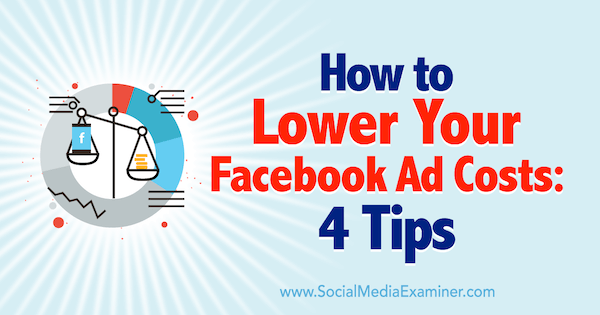
How Does Facebook Charge for Ads?
When you set up a Facebook campaign, you have two choices of how you're charged: impressions or link clicks.
Link clicks, often referred to as cost per click (CPC) bidding, is the more commonly used method. With this bid type, you're charged only when someone clicks on your Facebook ad.
If you opt to be charged by impression, you pay each time your ad is viewed—even if no one clicks on your ad. Facebook then calculates the cost per 1,000 impressions (CPM).
You can find and change how you get charged in the Budget & Schedule section of your Facebook ad set. However, some ad delivery settings restrict your options so your only choice is to be charged by impression.

What Determines Your Facebook Ad Costs?
A number of factors influence how much your Facebook ads cost. Having a solid understanding of these factors can help you pay less for your Facebook ads and get better results.
Here are the factors that make the biggest impact:
- Ad placement: All ad placements have a different CPC and impression. This means you can eliminate high-cost, low-performing placements to improve results.
- Relevance score: Your relevance score has a direct impact on how much you pay and how often your ad is shown. The higher your score, the less you'll pay and the better your results will be. Note: Facebook will soon replace the relevance score with three new relevance metrics.
- Bidding strategy: Each Facebook bidding strategy comes with its own unique advantages and disadvantages. You can prevent unnecessary, expensive clicks by setting a bid cap or target cost.
- Ad schedule: The time of year, day of the week, and time of day all impact the cost of your Facebook ads. Setting an ad schedule can help you reduce costs and maximize results.
- Audience: Facebook's ad real estate is limited and some audiences are more sought-after than others. This makes it more competitive and expensive to get your ads shown to certain audiences.
By controlling these factors and using the right optimizations, you can improve your results and lower your costs.
#1: Customize Collateral for Specific Facebook Ad Placements
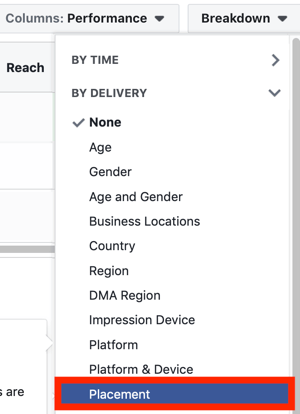
When you first run a new Facebook campaign, it's helpful to use all of the available placements so you can see which perform best, instead of making assumptions. After your ads have been running for a while, use the placement breakdown to determine which ones are getting you the best results.
To see your placement breakdown, open the Facebook Ads Manager dashboard and select the ad set you want to view. Next, click the Breakdown drop-down menu and choose By Delivery > Placement.
Now you can see a breakdown of how your ad set has performed across different placements. Facebook also shows you whether the placement appeared on desktop, mobile app, or mobile web.
Get World-Class Marketing Training — All Year Long!
Are you facing doubt, uncertainty, or overwhelm? The Social Media Marketing Society can help.
Each month, you’ll receive training from trusted marketing experts, covering everything from AI to organic social marketing. When you join, you’ll also get immediate access to:
- A library of 100+ marketing trainings
- A community of like-minded marketers
- Monthly online community meetups
- Relevant news and trends updates
For the campaign shown below, the mobile app Facebook news feed delivered significantly cheaper results than the other placements. Based on these results, you could easily lower your cost per result by excluding all of the other placements.
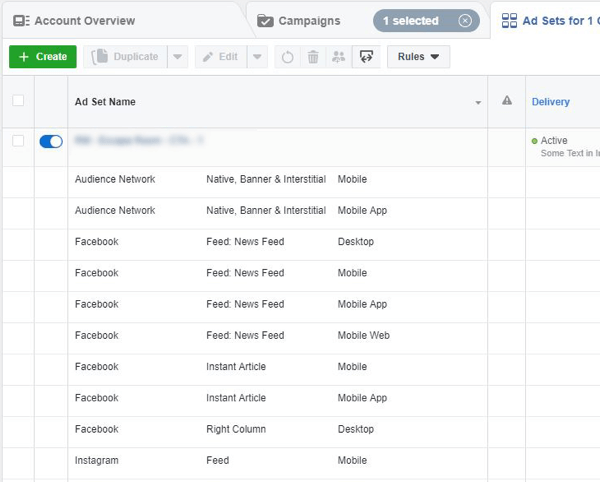
Lowering your costs by eliminating placements is easy to do, but it also limits your reach and potentially your results. A better approach is to customize your Facebook ads for each placement type first. All placements display ads differently, so create unique ads for each type of placement. It's helpful to be more granular with your Facebook ad structure before eliminating a specific placement.
#2: Test Your Facebook Advertising Bid Strategy
Facebook offers four bid strategies to choose from. However, your campaign goal and ad delivery optimization might limit your choices. To avoid limiting your bidding choices, set your campaign goal to Conversions. Bidding on conversions gives you more options and helps you get the best results from your Facebook ad campaigns.
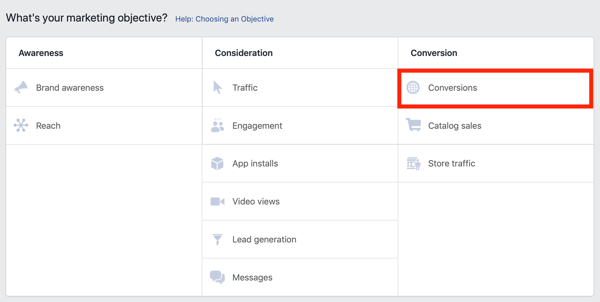
Once you've set up your campaign for conversions, you need to optimize your ad delivery and bidding strategy.
In the Budget & Schedule section of your ad set, click on the Optimization for Ad Delivery drop-down menu and select Conversions.

Next, select a bid strategy. Although Lowest Cost with a bid cap can get you the cheapest impressions and clicks, I've found it's lacking in the results category. In fact, it can prevent your ad from being shown to the right people in your audience. This can hurt your click-through rate, impact your relevance score, and make the clicks you do get cost more.
A Target Cost bidding strategy gives Facebook more wiggle room to get you high-quality placements while still maintaining a stable average cost. Better placements are also more likely to help you accomplish your goal, get more clicks, improve your relevance score, and lower your cost per result.

Overall, the bidding strategy you choose has a huge impact on how much you'll spend on your Facebook campaigns and how quickly you'll spend it. So don't be afraid to test different bidding strategies in addition to Target Cost. Testing will help you continually improve your bidding strategy and get cheaper results.
#3: Run Facebook Ads During Scheduled Hours and Days
You can use Facebook ad dayparting to pause and run your ads on specific days and times. The key to getting better results for lower cost is to schedule your ads to run only during historically high-performing times of the day. This helps you avoid wasting ad spend and make the most of a limited ad budget.

Discover Proven Marketing Strategies and Tips
Want to go even deeper with your marketing? Check out the Social Media Marketing Podcast! Publishing weekly since 2012, the Social Media Marketing Podcast helps you navigate the constantly changing marketing jungle, with expert interviews from marketing pros.
But don’t let the name fool you. This show is about a lot more than just social media marketing. With over 600 episodes and millions of downloads each year, this show has been a trusted source for marketers for well over a decade.
Before setting your ads up on a schedule, you need to meet a few requirements from Facebook.
First, change your budget to a lifetime budget. In the Budget & Schedule section of your ad set, click the Budget drop-down menu and select Lifetime Budget from the list to make the switch.

Next, set start and end dates for your ad set.
Then scroll down to the Ad Scheduling section and select Run Ads on a Schedule.
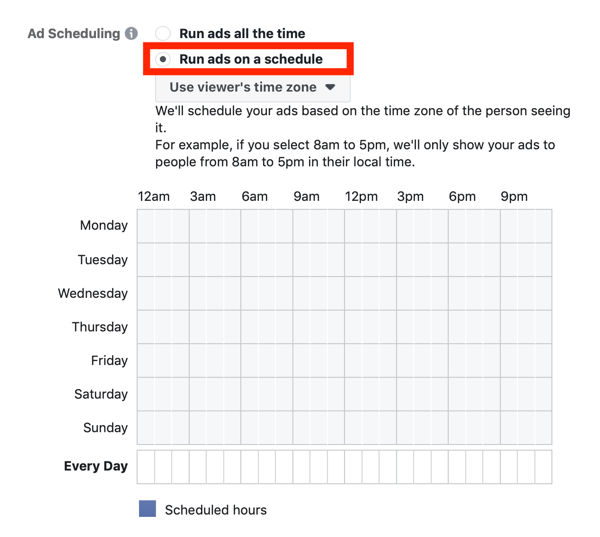
In the grid, highlight the days of the week and times of day you'd like your ads to run.
To determine which days and times typically get you the best results, check out your Facebook ads reports. In your Facebook Ads dashboard, click the Reports drop-down menu and select All > Time of Day (Viewer).
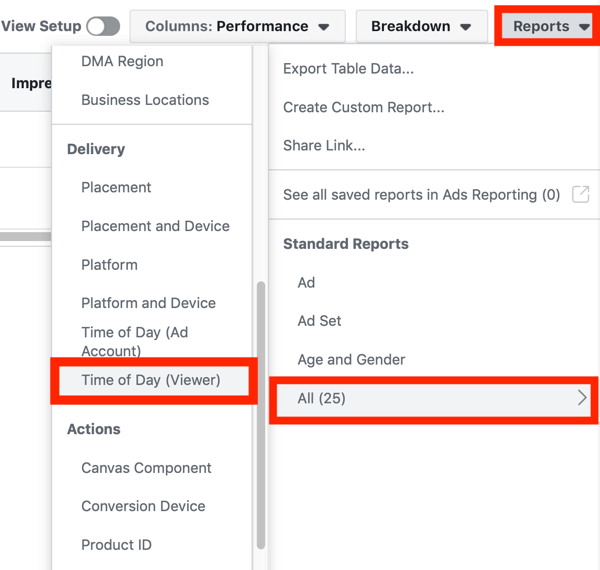
Next, you need to make one change to this report. On the left side of the screen, open the Metrics tab and type Spent in the search box. In the search results, select the Amount Spent checkbox to add the metric to your report.

Adding this column to your time of day report can help you identify times of day that cost you money but don't produce profitable sales. Then remove these times from your ad schedule. If you don't sell a product online and can't optimize for profitability, focus on the times of day that generate the highest-quality leads.

Scheduling your Facebook ads helps you minimize wasted ad spend and free up budget to spend during your most profitable hours.
Bonus Tip: After you set up your Facebook ads to run on a schedule, choose the Accelerated delivery type so your ads are shown as often as possible during your peak hours. When you opt for this approach, Facebook can spend your money much faster so keep a close eye on your ad spend if you're working with a limited budget.
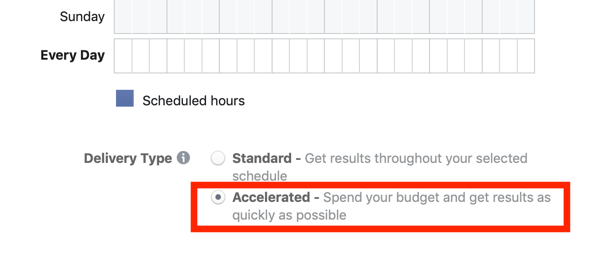
#4: Edit Facebook Custom and Lookalike Audience Segments
You already know that Facebook custom audiences and lookalike audiences typically outperform saved audiences and help bolster your relevance score. If you want to refine these audiences even further, combine saved audience criteria with your custom and lookalike audiences. Targeting these ultra-specific hybrid audiences allows you to focus on only your most profitable customers.
The first step is to look at how your audience is currently performing. In your Ads Manager dashboard, open your ad set. Then click the Breakdown drop-down menu and select By Delivery > Age.
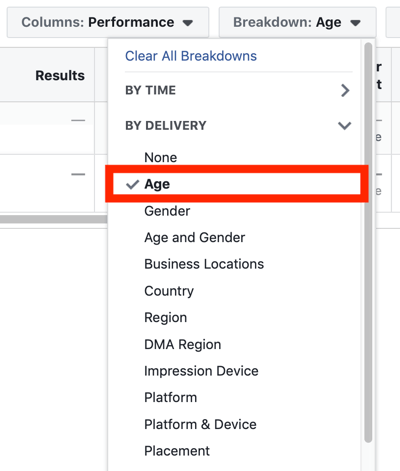
Now you can see a breakdown of how your ad set is performing with different age groups. Use the data from this report to improve your custom or lookalike audiences.
In the report shown below, the worst-performing age group is users 65+. The cost per result from users in this age group is nearly double the next highest group. A quick change to your audience targeting to exclude this age group would make a big impact on your average cost per result.

To make this change, open the ad set editor, scroll to the Audience section, and change your age settings to exclude the age groups that are negatively impacting your performance.

You can also customize your audiences in other ways. Head back to your ad set and look at your gender breakdown. Repeat the same process as above, and if you see a large enough difference, consider creating separate ad sets and ads that might appeal to each gender. This is usually a better approach than excluding a gender from your targeting altogether.
In addition to changing the age, gender, location, and language, you can also add detailed targeting criteria to your custom and lookalike audiences. This includes adding or excluding interests, behaviors, and complex demographic data. The more specific your targeting, the better you can match your ads to your audience.

When you make these changes to your ad targeting, you also need to be cognizant your audience's potential reach. A well-defined audience can improve your Facebook ad performance, but if your audience is too small, ad frequency could skyrocket. This may lead to people becoming annoyed with your ads and clicking the dreaded Hide Ad button. The end result could be a low ad relevance score, high costs, and poor results.
Conclusion
This article provides you with four ways to lower your cost per result and maximize the efficiency of your advertising budget. Use these tactics in combination with your overall Facebook ads strategy and you're sure to save money on your Facebook campaigns.
What do you think? Which of these tactics will you try first to lower your Facebook ad costs? Please share your thoughts in the comments below.
More articles on Facebook ads:
- Learn how to use automated rules to manage your Facebook ads.
- Find out how to research and test interests that yield new Facebook ad audiences.
- Discover seven reasons your Facebook ads don't convert.
Attention Agency Owners, Brand Marketers, and Consultants

Introducing the Marketing Agency Show–our newest podcast designed to explore the struggles of agency marketers.
Join show host and agency owner, Brooke Sellas, as she interviews agency marketers and digs deep into their biggest challenges. Explore topics like navigating rough economic times, leveraging AI, service diversification, client acquisition, and much more.
Just pull up your favorite podcast app, search for Marketing Agency Show and start listening. Or click the button below for more information.

